Full text
PDF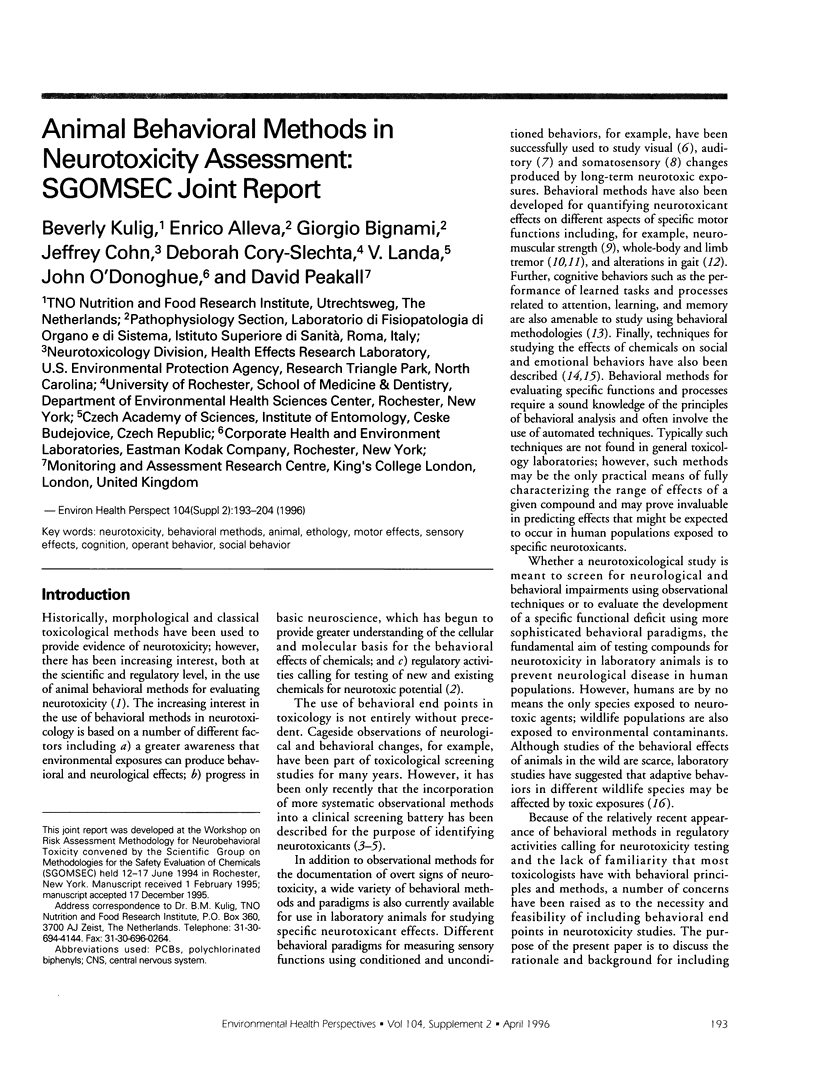
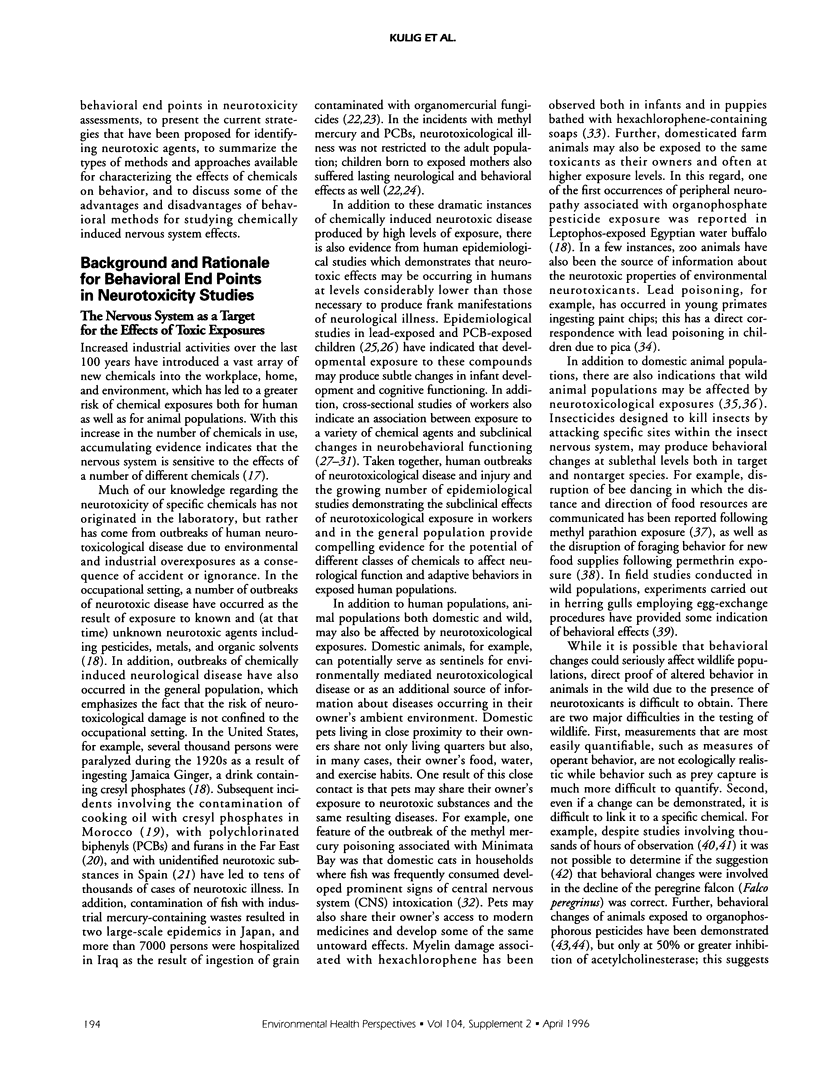
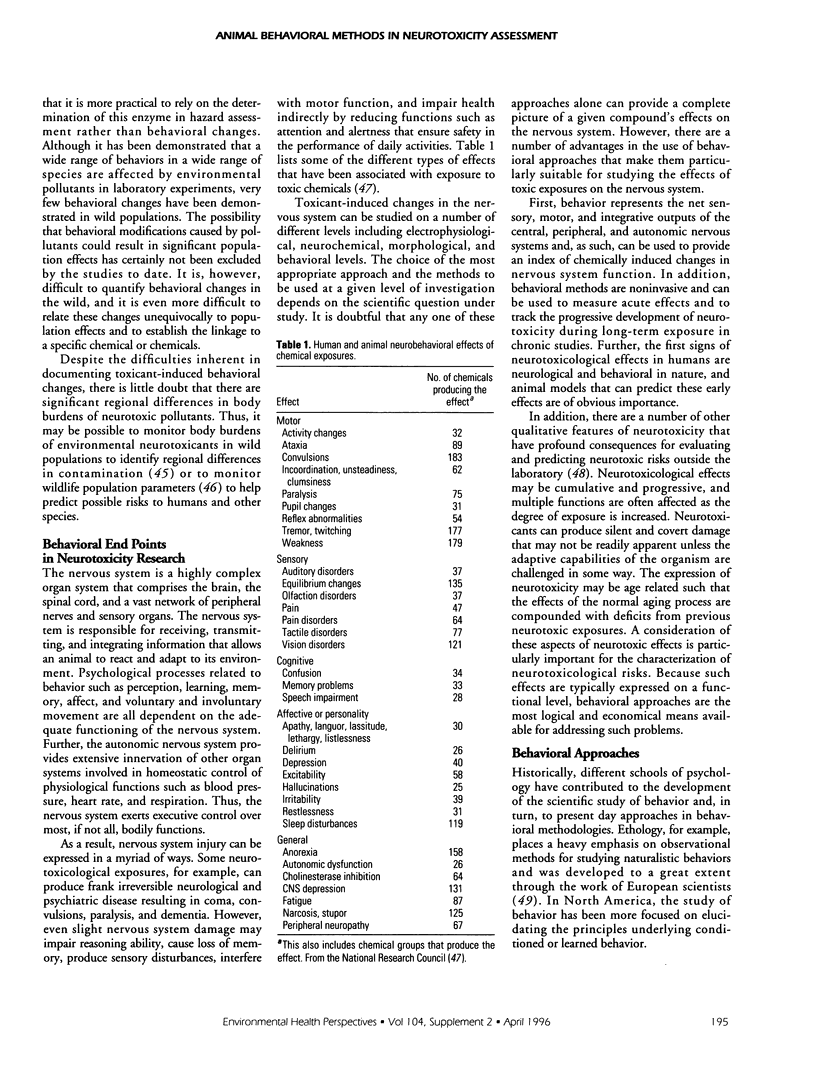
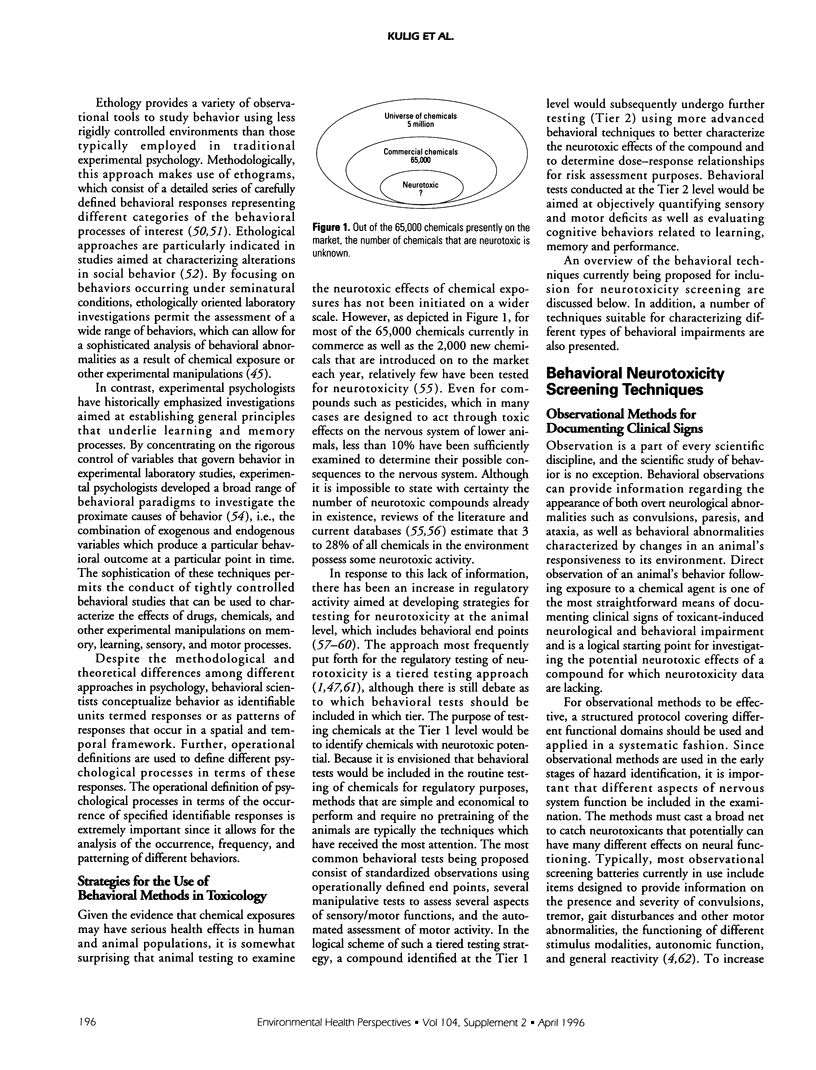
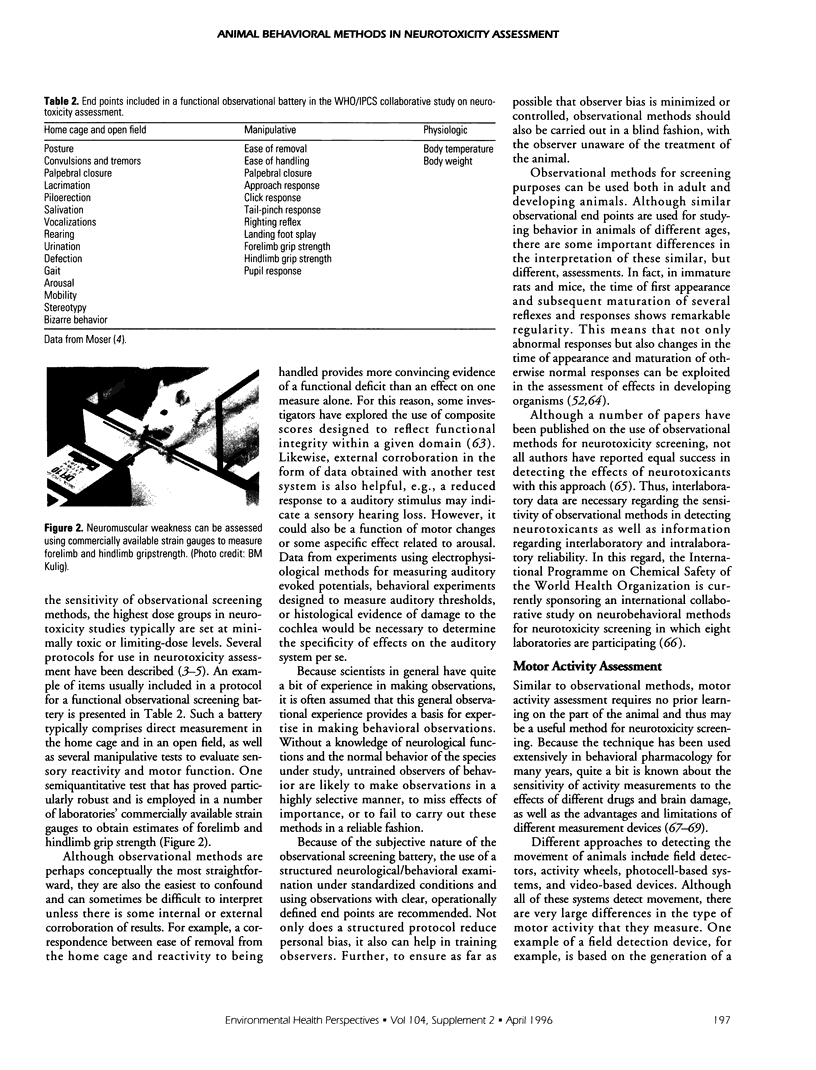
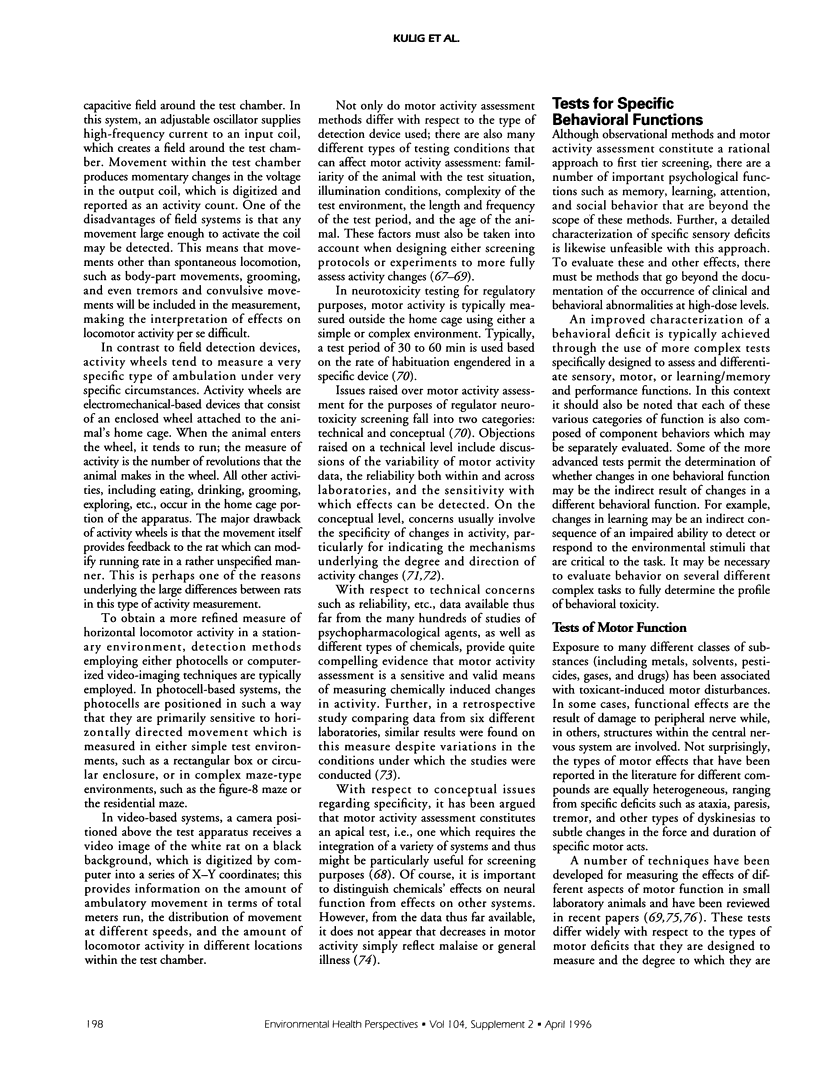
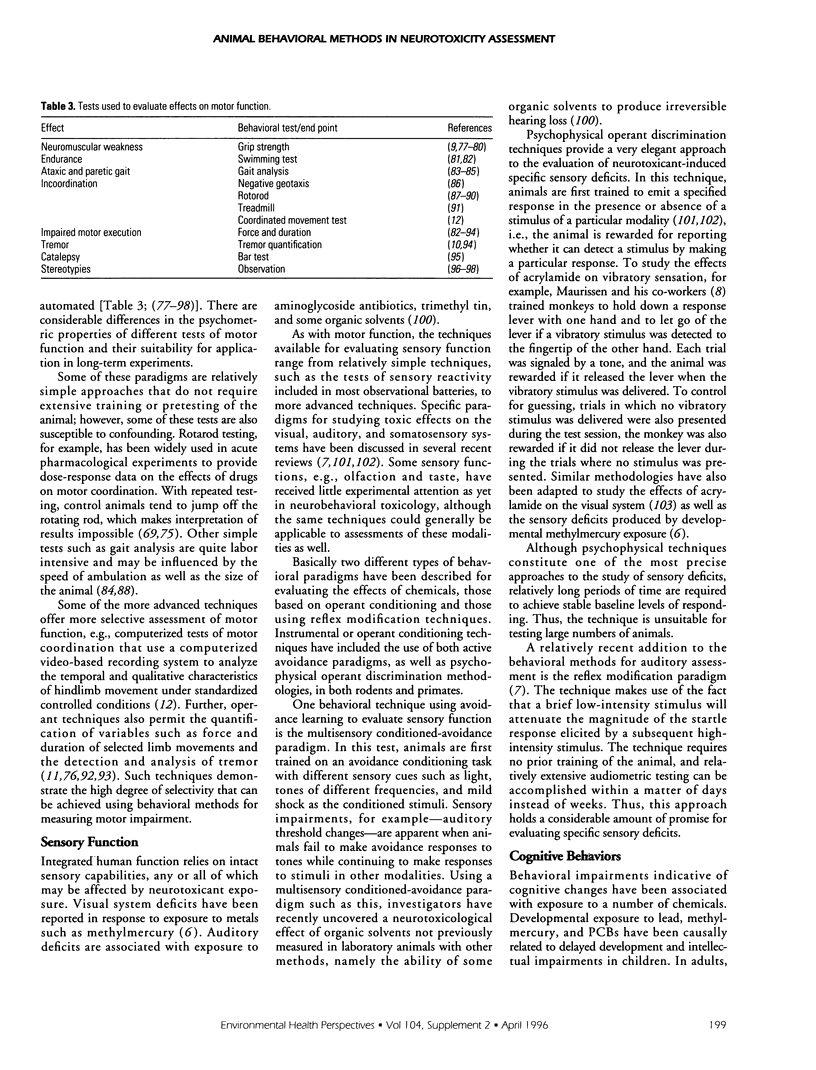
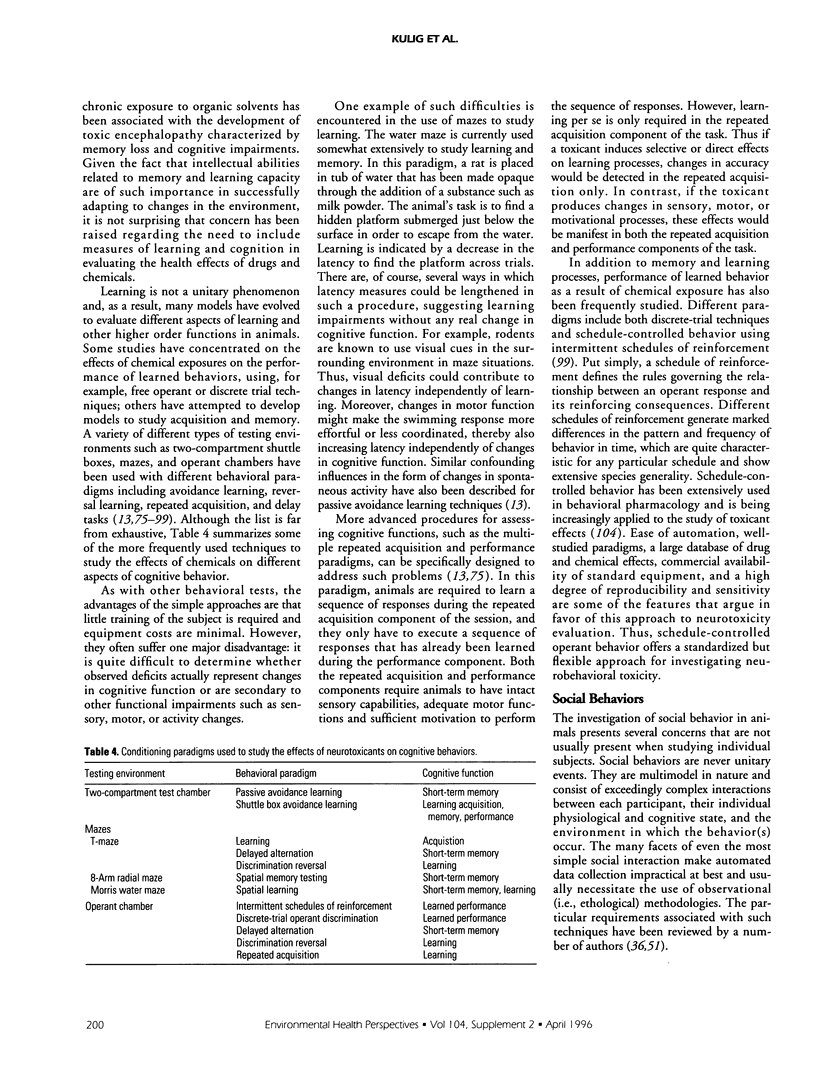
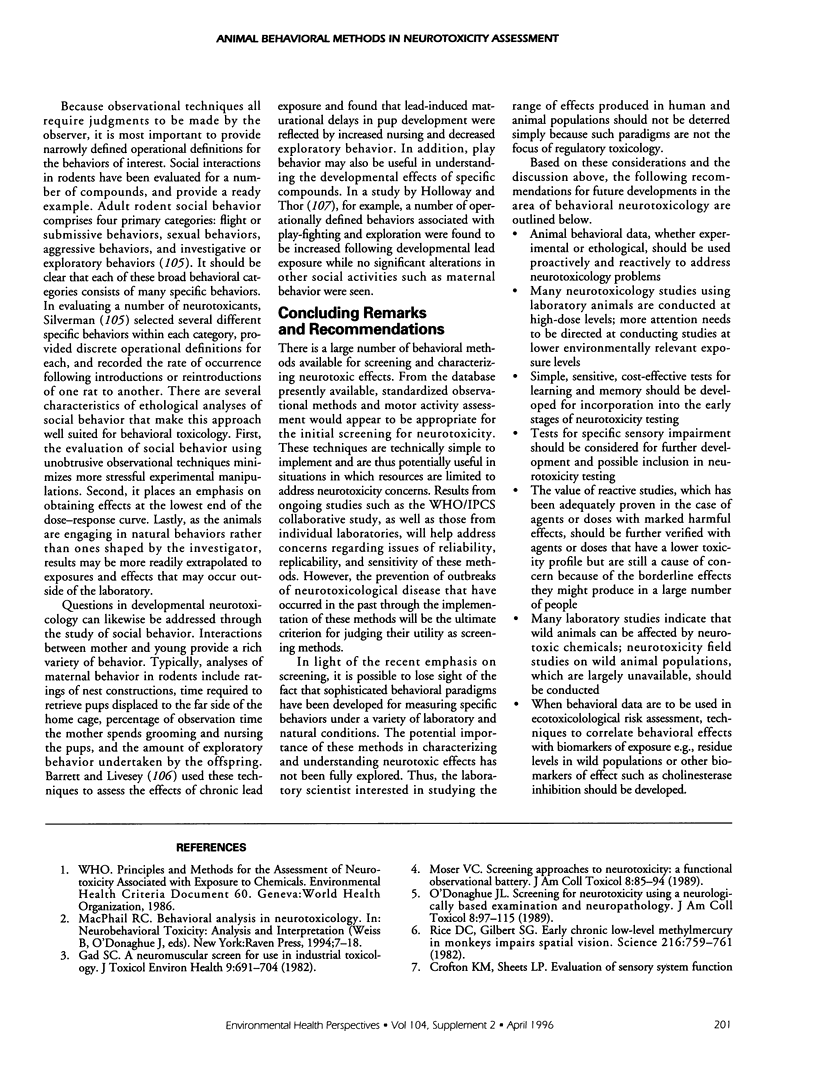
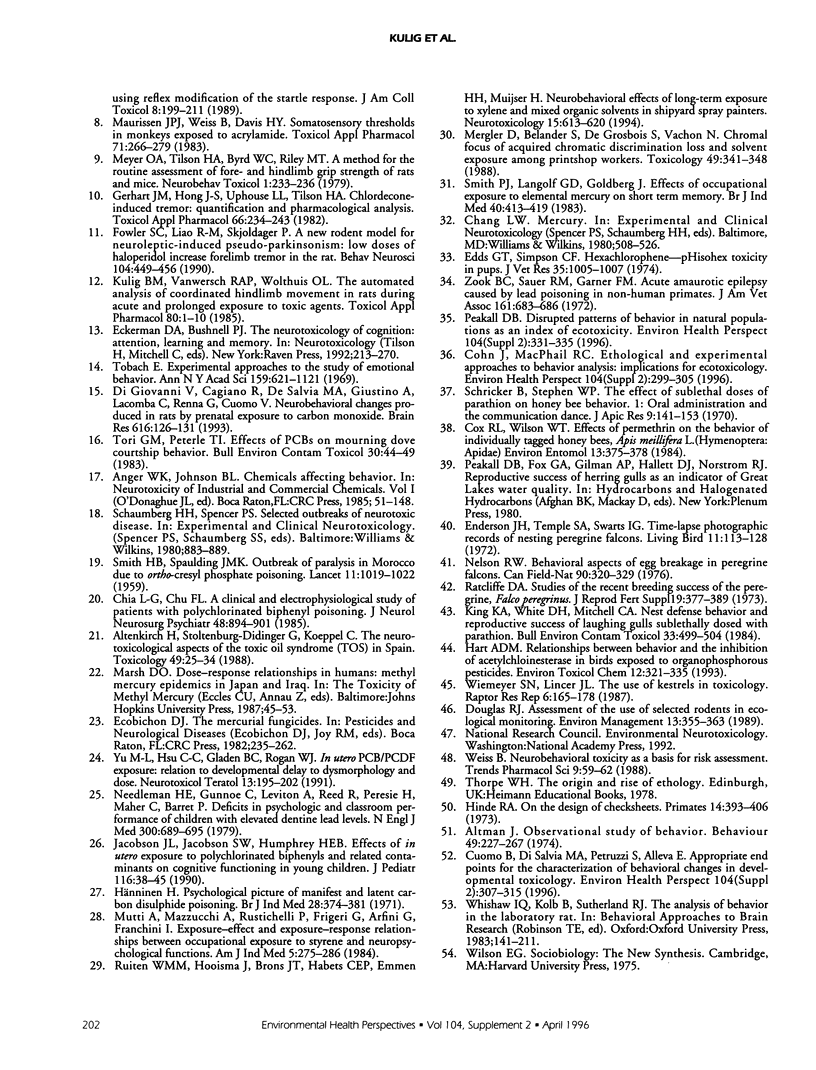
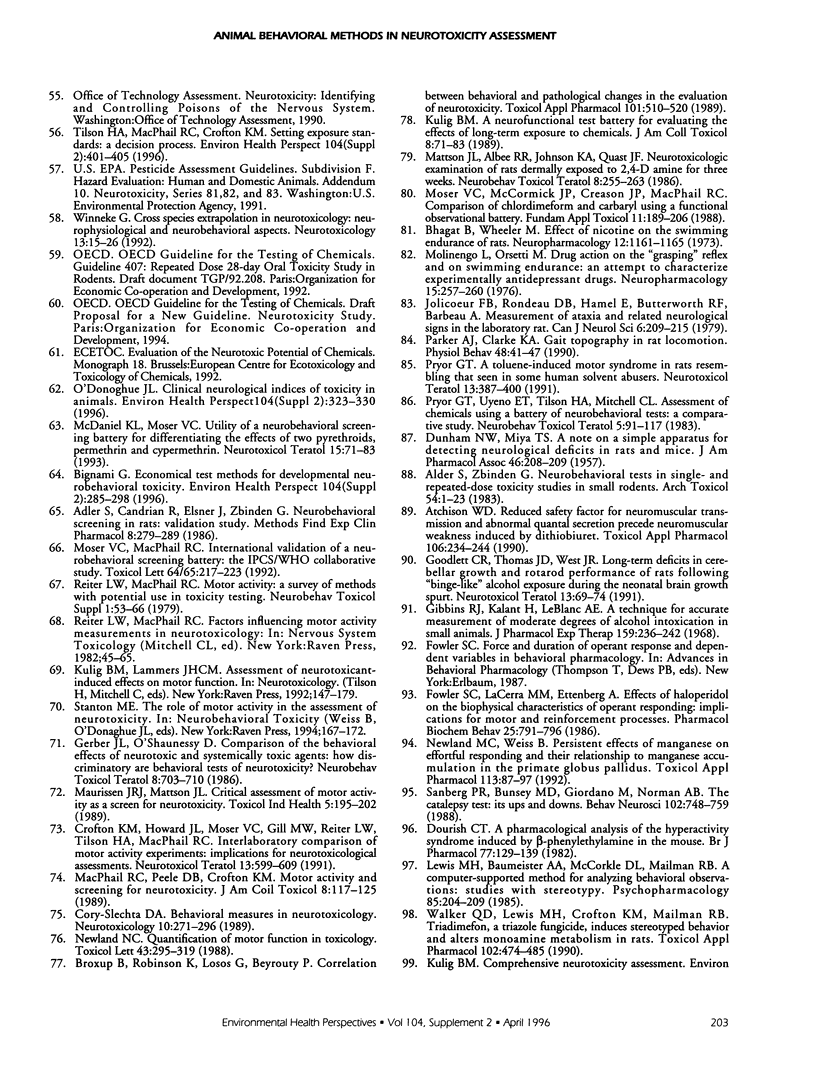
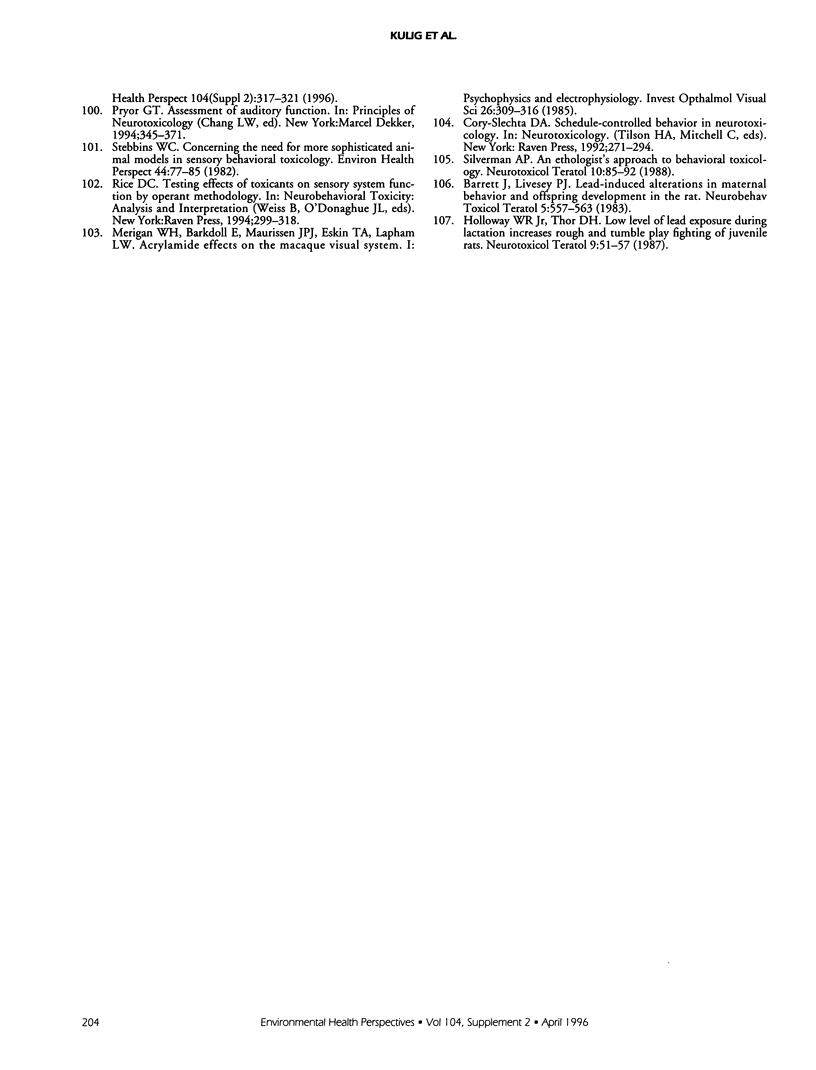
Images in this article
Selected References
These references are in PubMed. This may not be the complete list of references from this article.
- Alder S., Candrian R., Elsner J., Zbinden G. Neurobehavioral screening in rats: validation study. Methods Find Exp Clin Pharmacol. 1986 May;8(5):279–289. [PubMed] [Google Scholar]
- Alder S., Zbinden G. Neurobehavioral tests in single- and repeated-dose toxicity studies in small rodents. Arch Toxicol. 1983 Sep;54(1):1–23. doi: 10.1007/BF00277811. [DOI] [PubMed] [Google Scholar]
- Altenkirch H., Stoltenburg-Didinger G., Koeppel C. The neurotoxicological aspects of the toxic oil syndrome (TOS) in Spain. Toxicology. 1988 Apr;49(1):25–34. doi: 10.1016/0300-483x(88)90170-9. [DOI] [PubMed] [Google Scholar]
- Altmann J. Observational study of behavior: sampling methods. Behaviour. 1974;49(3):227–267. doi: 10.1163/156853974x00534. [DOI] [PubMed] [Google Scholar]
- Atchison W. D. Reduced safety factor for neuromuscular transmission and abnormal quantal secretion precede neuromuscular weakness induced by dithiobiuret. Toxicol Appl Pharmacol. 1990 Nov;106(2):234–244. doi: 10.1016/0041-008x(90)90243-n. [DOI] [PubMed] [Google Scholar]
- Barrett J., Livesey P. J. Lead induced alterations in maternal behavior and offspring development in the rat. Neurobehav Toxicol Teratol. 1983 Sep-Oct;5(5):557–563. [PubMed] [Google Scholar]
- Bhagat B., Wheeler N. Effect of nicotine on the swimming endurance of rats. Neuropharmacology. 1973 Dec;12(12):1161–1165. doi: 10.1016/0028-3908(73)90073-7. [DOI] [PubMed] [Google Scholar]
- Bignami G. Economical test methods for developmental neurobehavioral toxicity. Environ Health Perspect. 1996 Apr;104 (Suppl 2):285–298. doi: 10.1289/ehp.96104s2285. [DOI] [PMC free article] [PubMed] [Google Scholar]
- Broxup B., Robinson K., Losos G., Beyrouty P. Correlation between behavioral and pathological changes in the evaluation of neurotoxicity. Toxicol Appl Pharmacol. 1989 Dec;101(3):510–520. doi: 10.1016/0041-008x(89)90199-3. [DOI] [PubMed] [Google Scholar]
- Chia L. G., Chu F. L. A clinical and electrophysiological study of patients with polychlorinated biphenyl poisoning. J Neurol Neurosurg Psychiatry. 1985 Sep;48(9):894–901. doi: 10.1136/jnnp.48.9.894. [DOI] [PMC free article] [PubMed] [Google Scholar]
- Cohn J., MacPhail R. C. Ethological and experimental approaches to behavior analysis: implications for ecotoxicology. Environ Health Perspect. 1996 Apr;104 (Suppl 2):299–305. doi: 10.1289/ehp.96104s2299. [DOI] [PMC free article] [PubMed] [Google Scholar]
- Cory-Slechta D. A. Behavioral measures of neurotoxicity. Neurotoxicology. 1989 Summer;10(2):271–295. [PubMed] [Google Scholar]
- Crofton K. M., Howard J. L., Moser V. C., Gill M. W., Reiter L. W., Tilson H. A., MacPhail R. C. Interlaboratory comparison of motor activity experiments: implications for neurotoxicological assessments. Neurotoxicol Teratol. 1991 Nov-Dec;13(6):599–609. doi: 10.1016/0892-0362(91)90043-v. [DOI] [PubMed] [Google Scholar]
- Cuomo V., De Salvia M. A., Petruzzi S., Alleva E. Appropriate end points for the characterization of behavioral changes in developmental toxicology. Environ Health Perspect. 1996 Apr;104 (Suppl 2):307–315. doi: 10.1289/ehp.96104s2307. [DOI] [PMC free article] [PubMed] [Google Scholar]
- DUNHAM N. W., MIYA T. S. A note on a simple apparatus for detecting neurological deficit in rats and mice. J Am Pharm Assoc Am Pharm Assoc. 1957 Mar;46(3):208–209. doi: 10.1002/jps.3030460322. [DOI] [PubMed] [Google Scholar]
- Di Giovanni V., Cagiano R., De Salvia M. A., Giustino A., Lacomba C., Renna G., Cuomo V. Neurobehavioral changes produced in rats by prenatal exposure to carbon monoxide. Brain Res. 1993 Jul 9;616(1-2):126–131. doi: 10.1016/0006-8993(93)90200-7. [DOI] [PubMed] [Google Scholar]
- Dourish C. T. A pharmacological analysis of the hyperactivity syndrome induced by beta-phenylethylamine in the mouse. Br J Pharmacol. 1982 Sep;77(1):129–139. doi: 10.1111/j.1476-5381.1982.tb09278.x. [DOI] [PMC free article] [PubMed] [Google Scholar]
- Edds G. T., Simpson C. F. Hexachlorophene-pHisohex toxicity in pups. Am J Vet Res. 1974 Jul;35(7):1005–1007. [PubMed] [Google Scholar]
- Fowler S. C., LaCerra M. M., Ettenberg A. Effects of haloperidol on the biophysical characteristics of operant responding: implications for motor and reinforcement processes. Pharmacol Biochem Behav. 1986 Oct;25(4):791–796. doi: 10.1016/0091-3057(86)90389-8. [DOI] [PubMed] [Google Scholar]
- Fowler S. C., Liao R. M., Skjoldager P. A new rodent model for neuroleptic-induced pseudo-parkinsonism: low doses of haloperidol increase forelimb tremor in the rat. Behav Neurosci. 1990 Jun;104(3):449–456. doi: 10.1037//0735-7044.104.3.449. [DOI] [PubMed] [Google Scholar]
- Gad S. C. A neuromuscular screen for use in industrial toxicology. J Toxicol Environ Health. 1982 May-Jun;9(5-6):691–704. doi: 10.1080/15287398209530197. [DOI] [PubMed] [Google Scholar]
- Gerber G. J., O'Shaughnessy D. Comparison of the behavioral effects of neurotoxic and systemically toxic agents: how discriminatory are behavioral tests of neurotoxicity? Neurobehav Toxicol Teratol. 1986 Nov-Dec;8(6):703–710. [PubMed] [Google Scholar]
- Gerhart J. M., Hong J. S., Uphouse L. L., Tilson H. A. Chlordecone-induced tremor: quantification and pharmacological analysis. Toxicol Appl Pharmacol. 1982 Nov;66(2):234–243. doi: 10.1016/0041-008x(82)90288-5. [DOI] [PubMed] [Google Scholar]
- Gibbins R. J., Kalant H., Le Blanc A. E. A technique for accurate measurement of moderate degrees of alcohol intoxication in small animals. J Pharmacol Exp Ther. 1968 Jan;159(1):236–242. [PubMed] [Google Scholar]
- Goodlett C. R., Thomas J. D., West J. R. Long-term deficits in cerebellar growth and rotarod performance of rats following "binge-like" alcohol exposure during the neonatal brain growth spurt. Neurotoxicol Teratol. 1991 Jan-Feb;13(1):69–74. doi: 10.1016/0892-0362(91)90029-v. [DOI] [PubMed] [Google Scholar]
- Holloway W. R., Jr, Thor D. H. Low level lead exposure during lactation increases rough and tumble play fighting of juvenile rats. Neurotoxicol Teratol. 1987 Jan-Feb;9(1):51–57. doi: 10.1016/0892-0362(87)90070-5. [DOI] [PubMed] [Google Scholar]
- Hänninen H. Psychological picture of manifest and latent carbon disulphide poisoning. Br J Ind Med. 1971 Oct;28(4):374–381. [PMC free article] [PubMed] [Google Scholar]
- Jacobson J. L., Jacobson S. W., Humphrey H. E. Effects of in utero exposure to polychlorinated biphenyls and related contaminants on cognitive functioning in young children. J Pediatr. 1990 Jan;116(1):38–45. doi: 10.1016/s0022-3476(05)81642-7. [DOI] [PubMed] [Google Scholar]
- Jolicoeur F. B., Rondeau D. B., Hamel E., Butterworth R. F., Barbeau A. Measurement of ataxia and related neurological signs in the laboratory rat. Can J Neurol Sci. 1979 May;6(2):209–215. doi: 10.1017/s0317167100119663. [DOI] [PubMed] [Google Scholar]
- King K. A., White D. H., Mitchell C. A. Nest defense behavior and reproductive success of laughing gulls sublethally dosed with parathion. Bull Environ Contam Toxicol. 1984 Oct;33(4):499–504. doi: 10.1007/BF01625575. [DOI] [PubMed] [Google Scholar]
- Kulig B. M., Vanwersch R. A., Wolthuis O. L. The automated analysis of coordinated hindlimb movement in rats during acute and prolonged exposure to toxic agents. Toxicol Appl Pharmacol. 1985 Aug;80(1):1–10. doi: 10.1016/0041-008x(85)90095-x. [DOI] [PubMed] [Google Scholar]
- Lewis M. H., Baumeister A. A., McCorkle D. L., Mailman R. B. A computer-supported method for analyzing behavioral observations: studies with stereotypy. Psychopharmacology (Berl) 1985;85(2):204–209. doi: 10.1007/BF00428415. [DOI] [PubMed] [Google Scholar]
- Mattsson J. L., Albee R. R., Johnson K. A., Quast J. F. Neurotoxicologic examination of rats dermally exposed to 2,4-D amine for three weeks. Neurobehav Toxicol Teratol. 1986 May-Jun;8(3):255–263. [PubMed] [Google Scholar]
- Maurissen J. P., Mattsson J. L. Critical assessment of motor activity as a screen for neurotoxicity. Toxicol Ind Health. 1989 Mar;5(2):195–202. doi: 10.1177/074823378900500205. [DOI] [PubMed] [Google Scholar]
- Maurissen J. P., Weiss B., Davis H. T. Somatosensory thresholds in monkeys exposed to acrylamide. Toxicol Appl Pharmacol. 1983 Nov;71(2):266–279. doi: 10.1016/0041-008x(83)90343-5. [DOI] [PubMed] [Google Scholar]
- McDaniel K. L., Moser V. C. Utility of a neurobehavioral screening battery for differentiating the effects of two pyrethroids, permethrin and cypermethrin. Neurotoxicol Teratol. 1993 Mar-Apr;15(2):71–83. doi: 10.1016/0892-0362(93)90065-v. [DOI] [PubMed] [Google Scholar]
- Mergler D., Bélanger S., De Grosbois S., Vachon N. Chromal focus of acquired chromatic discrimination loss and solvent exposure among printshop workers. Toxicology. 1988 May;49(2-3):341–348. doi: 10.1016/0300-483x(88)90017-0. [DOI] [PubMed] [Google Scholar]
- Merigan W. H., Barkdoll E., Maurissen J. P., Eskin T. A., Lapham L. W. Acrylamide effects on the macaque visual system. I. Psychophysics and electrophysiology. Invest Ophthalmol Vis Sci. 1985 Mar;26(3):309–316. [PubMed] [Google Scholar]
- Meyer O. A., Tilson H. A., Byrd W. C., Riley M. T. A method for the routine assessment of fore- and hindlimb grip strength of rats and mice. Neurobehav Toxicol. 1979 Fall;1(3):233–236. [PubMed] [Google Scholar]
- Molinengo L., Orsetti M. Drug action on the "grasping" reflex and on swimming endurance; an attempt to characterize experimentally antidepressant drugs. Neuropharmacology. 1976 Apr;15(4):257–260. doi: 10.1016/0028-3908(76)90073-3. [DOI] [PubMed] [Google Scholar]
- Moser V. C., MacPhail R. C. International validation of a neurobehavioral screening battery: the IPCS/WHO collaborative study. Toxicol Lett. 1992 Dec;64-65 Spec No:217–223. doi: 10.1016/0378-4274(92)90192-m. [DOI] [PubMed] [Google Scholar]
- Moser V. C., McCormick J. P., Creason J. P., MacPhail R. C. Comparison of chlordimeform and carbaryl using a functional observational battery. Fundam Appl Toxicol. 1988 Aug;11(2):189–206. doi: 10.1016/0272-0590(88)90144-3. [DOI] [PubMed] [Google Scholar]
- Mutti A., Mazzucchi A., Rustichelli P., Frigeri G., Arfini G., Franchini I. Exposure-effect and exposure-response relationships between occupational exposure to styrene and neuropsychological functions. Am J Ind Med. 1984;5(4):275–286. doi: 10.1002/ajim.4700050404. [DOI] [PubMed] [Google Scholar]
- Needleman H. L., Gunnoe C., Leviton A., Reed R., Peresie H., Maher C., Barrett P. Deficits in psychologic and classroom performance of children with elevated dentine lead levels. N Engl J Med. 1979 Mar 29;300(13):689–695. doi: 10.1056/NEJM197903293001301. [DOI] [PubMed] [Google Scholar]
- Newland M. C. Quantification of motor function in toxicology. Toxicol Lett. 1988 Oct;43(1-3):295–319. doi: 10.1016/0378-4274(88)90035-5. [DOI] [PubMed] [Google Scholar]
- Newland M. C., Weiss B. Persistent effects of manganese on effortful responding and their relationship to manganese accumulation in the primate globus pallidus. Toxicol Appl Pharmacol. 1992 Mar;113(1):87–97. doi: 10.1016/0041-008x(92)90012-h. [DOI] [PubMed] [Google Scholar]
- O'Donoghue J. L. Clinical neurologic indices of toxicity in animals. Environ Health Perspect. 1996 Apr;104 (Suppl 2):323–330. doi: 10.1289/ehp.96104s2323. [DOI] [PMC free article] [PubMed] [Google Scholar]
- Parker A. J., Clarke K. A. Gait topography in rat locomotion. Physiol Behav. 1990 Jul;48(1):41–47. doi: 10.1016/0031-9384(90)90258-6. [DOI] [PubMed] [Google Scholar]
- Peakall D. B. Disrupted patterns of behavior in natural populations as an index of ecotoxicity. Environ Health Perspect. 1996 Apr;104 (Suppl 2):331–335. doi: 10.1289/ehp.96104s2331. [DOI] [PMC free article] [PubMed] [Google Scholar]
- Pryor G. T. A toluene-induced motor syndrome in rats resembling that seen in some human solvent abusers. Neurotoxicol Teratol. 1991 Jul-Aug;13(4):387–400. doi: 10.1016/0892-0362(91)90087-d. [DOI] [PubMed] [Google Scholar]
- Pryor G. T., Uyeno E. T., Tilson H. A., Mitchell C. L. Assessment of chemicals using a battery of neurobehavioral tests: a comparative study. Neurobehav Toxicol Teratol. 1983 Jan-Feb;5(1):91–117. [PubMed] [Google Scholar]
- Reiter L. W., MacPhail R. C. Motor activity: a survey of methods with potential use in toxicity testing. Neurobehav Toxicol. 1979;1 (Suppl 1):53–66. [PubMed] [Google Scholar]
- Rice D. C., Gilbert S. G. Early chronic low-level methylmercury poisoning in monkeys impairs spatial vision. Science. 1982 May 14;216(4547):759–761. doi: 10.1126/science.7079739. [DOI] [PubMed] [Google Scholar]
- Ruijten M. W., Hooisma J., Brons J. T., Habets C. E., Emmen H. H., Muijser H. Neurobehavioral effects of long-term exposure to xylene and mixed organic solvents in shipyard spray painters. Neurotoxicology. 1994 Fall;15(3):613–620. [PubMed] [Google Scholar]
- SMITH H. V., SPALDING J. M. Outbreak of paralysis in Morocco due to ortho-cresyl phosphate poisoning. Lancet. 1959 Dec 5;2(7110):1019–1021. doi: 10.1016/s0140-6736(59)91486-2. [DOI] [PubMed] [Google Scholar]
- Sanberg P. R., Bunsey M. D., Giordano M., Norman A. B. The catalepsy test: its ups and downs. Behav Neurosci. 1988 Oct;102(5):748–759. doi: 10.1037//0735-7044.102.5.748. [DOI] [PubMed] [Google Scholar]
- Silverman A. P. An ethologist's approach to behavioural toxicology. Neurotoxicol Teratol. 1988 Mar-Apr;10(2):85–92. doi: 10.1016/0892-0362(88)90071-2. [DOI] [PubMed] [Google Scholar]
- Smith P. J., Langolf G. D., Goldberg J. Effect of occupational exposure to elemental mercury on short term memory. Br J Ind Med. 1983 Nov;40(4):413–419. doi: 10.1136/oem.40.4.413. [DOI] [PMC free article] [PubMed] [Google Scholar]
- Stebbins W. C. Concerning the need for more sophisticated animal models in sensory behavioral toxicology. Environ Health Perspect. 1982 Apr;44:77–85. doi: 10.1289/ehp.824477. [DOI] [PMC free article] [PubMed] [Google Scholar]
- Tilson H. A., MacPhail R. C., Crofton K. M. Setting exposure standards: a decision process. Environ Health Perspect. 1996 Apr;104 (Suppl 2):401–405. doi: 10.1289/ehp.96104s2401. [DOI] [PMC free article] [PubMed] [Google Scholar]
- Tori G. M., Peterle T. J. Effects of PCBs on mourning dove courtship behavior. Bull Environ Contam Toxicol. 1983 Jan;30(1):44–49. doi: 10.1007/BF01610097. [DOI] [PubMed] [Google Scholar]
- Walker Q. D., Lewis M. H., Crofton K. M., Mailman R. B. Triadimefon, a triazole fungicide, induces stereotyped behavior and alters monoamine metabolism in rats. Toxicol Appl Pharmacol. 1990 Mar 1;102(3):474–485. doi: 10.1016/0041-008x(90)90043-t. [DOI] [PubMed] [Google Scholar]
- Weiss B. Neurobehavioral toxicity as a basis for risk assessment. Trends Pharmacol Sci. 1988 Feb;9(2):59–62. doi: 10.1016/0165-6147(88)90118-6. [DOI] [PubMed] [Google Scholar]
- Winneke G. Cross species extrapolation in neurotoxicology: neurophysiological and neurobehavioral aspects. Neurotoxicology. 1992 Spring;13(1):15–25. [PubMed] [Google Scholar]
- Yu M. L., Hsu C. C., Gladen B. C., Rogan W. J. In utero PCB/PCDF exposure: relation of developmental delay to dysmorphology and dose. Neurotoxicol Teratol. 1991 Mar-Apr;13(2):195–202. doi: 10.1016/0892-0362(91)90011-k. [DOI] [PubMed] [Google Scholar]
- Zook B. C., Sauer R. M., Garner F. M. Acute amaurotic epilepsy caused by lead poisoning in nonhuman primates. J Am Vet Med Assoc. 1972 Sep 15;161(6):683–686. [PubMed] [Google Scholar]



